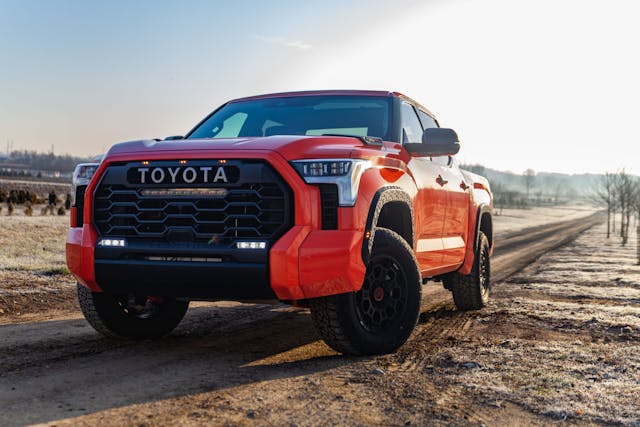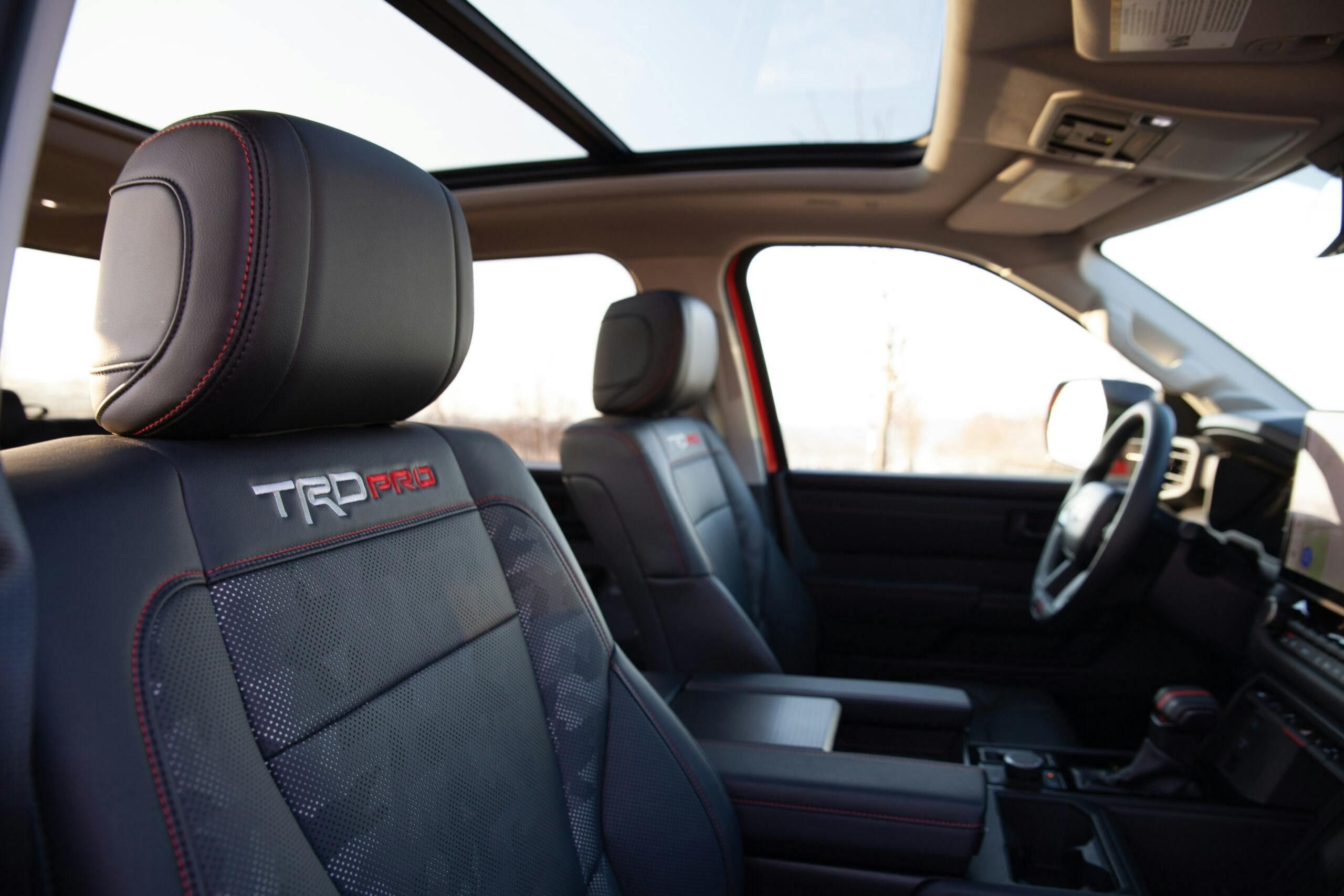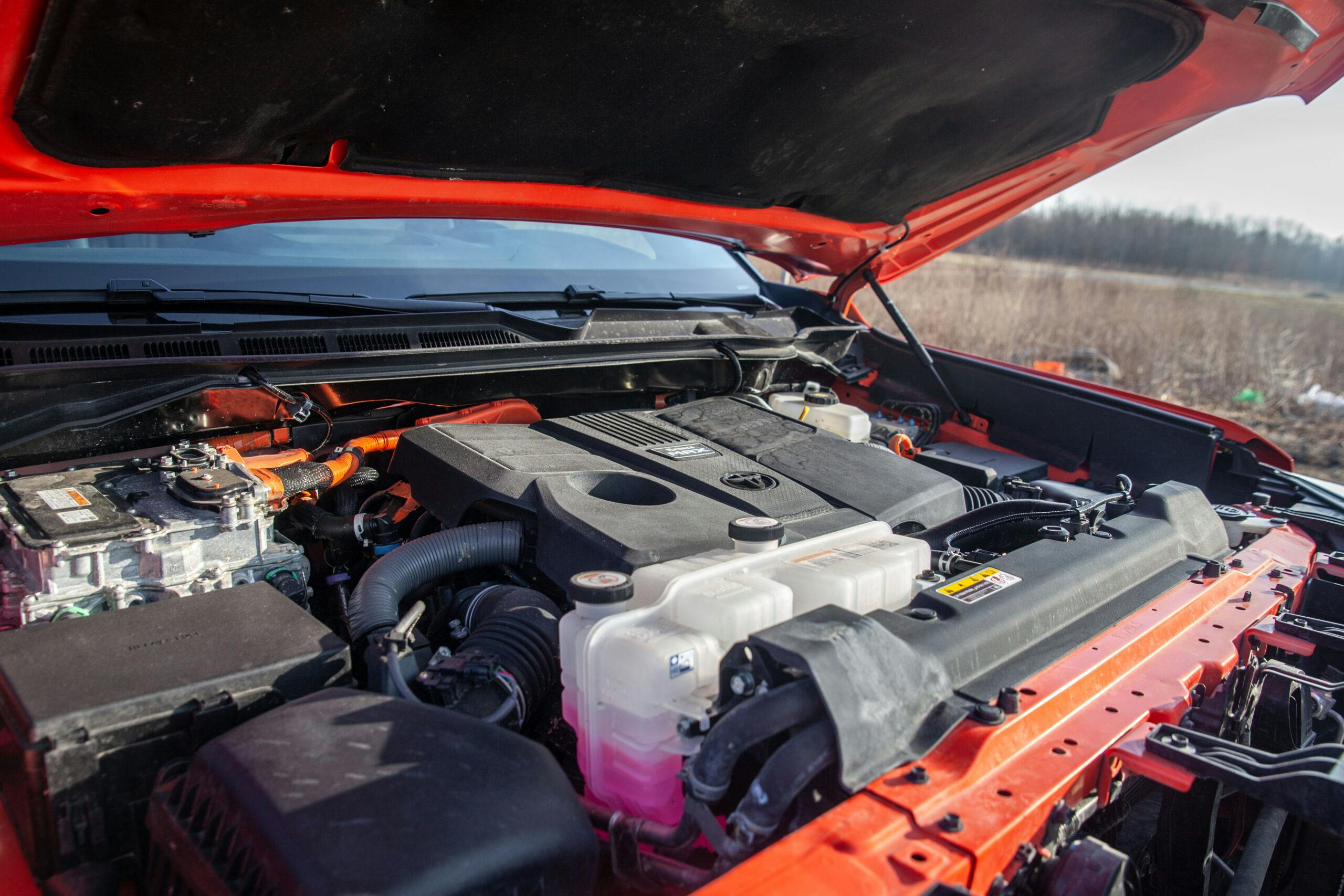Media | Articles
2022 Toyota Tundra TRD Pro Review: Respectable Un-Raptor
The Tundra has always seemed like the truck for people who aren’t into trucks. With car-like road manners and Camry-like reliability, the Toyota has long been the full-size pickup of choice for sensible suburbanites. It may not match the best from Detroit in brute ability, but it’s a great answer for runs to the hardware store, moving mulch, and hauling the family camper or boat.
In 2015, Toyota took the Tundra in an uncharacteristic direction. The typically conservative brand decided its largest truck should compete with the creatine-snorting, trail-pounding Ford F-150 Raptor. The resulting model, the Tundra TRD Pro, was an evolution of the Tundra’s existing TRD off-road package. (The letters stand for Toyota Racing Development, the company’s in-house tuning arm.) Chassis changes were minimal, not much more than a lift and Bilstein remote-reservoir shocks. Styling was subdued, and the engine was an unmodified version of the base truck’s 381-hp V-8. Most boys picked the Ford for the square dance.
That generation of Tundra was in production for 14 years, and the TRD Pro trim stuck around to the end. When the truck was finally redesigned for 2022, the model returned. This latest entry into the Baja-runner-for-the-street market is a more serious effort.

At $69,420—no jokes, that’s actually the base price—the current TRD Pro package is the second most expensive Tundra on offer. That price nets you matte-black 18-inch BBS alloy wheels; beefy 33-inch, 285-section Falken Wildpeak all-terrain tires; Fox internal-bypass remote-reservoir shocks; a 1.1-inch lift; a new front anti-roll bar, and underbody protection. You also get plenty of exterior styling touches, including a built-in grille light bar and carbon-fiber-meets-digital-camo black-plastic exterior trim.
If you want a long bed, you’re out of luck: All TRD Pros are crew-cab only, with a short, 5.5-foot bed. The only available engine is a 3.4-liter, twin-turbo hybrid V-6 making 437 hp and 583 lb-ft.
Marketplace
Buy and sell classics with confidence
Since my work schedule didn’t allow for any serious off-roading—and not least because Baja-style trucks sell largely on perception—I decided to road-trip the Tundra from Hagerty’s editorial office in Ann Arbor, Michigan to my hometown in Southern Ohio. Rams, F-150s, and Silverados are king there, as in Michigan, but there’s no hometown-manufacturer bias. I was curious how the full-size-truck faithful would react.
With disdain, it turns out. At a brewery in Xenia, I overhead a man in a Heartbeat of America: Chevrolet hat say, “Who’s the ***** with the orange Tundra parked out back?”
The Toyota is extroverted and conspicuous and our test truck’s paint didn’t help. Solar Octane orange is a $425 option, the color of C4 pre-workout powder. It stood out in Ohio’s monochrome traffic, as did the Tundra’s glaring headlights, bulging fender flares, and chiseled chin. The truck wants you know the TRD Pro is for certified tough guys, whether the driver is one or not.
The interior treatment is similar. At first glance, it seems as if every surface wears a logo. The passenger side of the dashboard says TOYOTA in fat raised letters, in case you’ve forgotten. The seats are finished in synthetic leather that makes cleaning up after muddy excursions a breeze, but the camo pattern on their centers matches that funky exterior trim.
Raptors attract one kind of person, and the TRD Pro attracted another. At one point, a sweater-clad man pulled up next to me in a Toyota RAV4 Prime, keen on the big orange Tundra. He wanted to know if it came with Toyota’s latest suite of driver aids, and it does: automatic emergency braking with pedestrian detection, adaptive cruise control, lane-departure warning, lane-keep assist, automatic high beams, and traffic-sign recognition.
The Tundra’s powertrain was of equal interest to sweater-man. That hybrid V-6 produces 13 fewer horsepower than the 3.5-liter, twin-turbo V-6 in the Raptor but makes 73 more lb-ft of torque. Like all four-wheel-drive Tundras, the TRD Pro’s ten-speed automatic is paired to a part-time system with an electronically controlled, two-speed transfer case, and a locking rear differential.
It’s quick. Not as quick as the roided-out Ford or the similar Ram TRX, but more than you expect from a vehicle weighing nearly 6200 pounds. Sixty mph arrives in 5.7 seconds, about the same as in a Nissan 350Z. Sports cars of yesteryear, beware.
Specs: 2022 Toyota Tundra TRD Pro
• Price: $69,420 / $69,845 (base / as-tested)
• Powertrain: 3.4-liter, twin-turbo hybrid V-6
• Output: 389 hp and 479 lb-ft (engine only) 437 hp and 583 lb-ft (hybrid combined)
• Layout: Four-wheel-drive, four-door, five-passenger truck
• Weight: 6172 lbs
• EPA Fuel Economy: 18/20/19 mpg (city/hwy/combined)
• 0–60 mph: 5.7 seconds
• Competition: Chevrolet Silverado 1500 ZR2, Ford F-150 Raptor, Ram TRX
What It Does Well
Comfortable cruising. Washboard pavement is handled with ease. Driver aids like the lane-keep assist were useful in keeping this behemoth centered in the lane. Interior space is limo-like, and the eight-way power-adjustable seats are an easy place to get comfortable.
The enormous, 14-inch center touchscreen hosts a well-thought-out and responsive infotainment interface. Menu diving is kept to a minimum for essential functions. Connecting a phone via wireless Android Auto was easy. (Note to other automakers: Corded Apple CarPlay and Android Auto ain’t it, and haven’t been for years.) The 12-speaker JBL sound system was equally suited to talk radio and Lynyrd Skynyrd’s One More from the Road.
Make no mistake: This is a big freaking truck for around-town use. However, the overhead camera and parking sensors make parking in tight spaces a no-brainer. The built-in bed ties, a bevy of trailer towing aids, and a 120V/400W, bed-mounted AC power outlet are genuinely useful. That said, if you simply need to haul antiques home from the flea market, the TRD is great at that, too.
Changes We’d Make
Big off-road trucks are all about hyperbole, and this one needs more. More power, larger tires, more suspension lift, crazier bodywork. How else will you let the other bros know your truck is the gnarliest?
The fake V-8 noise piped into the cabin through the stereo speakers is as unconvincing as the engine sounds in the first Gran Turismo game. Ford found a way to make the Raptor’s V-6 sound good. Why did Toyota resort to a synthesized note?
Real-world fuel economy is less than impressive. The TRD Pro is EPA-rated at 18/20 mpg city/highway, but over a few hundred miles of varied-speed highway testing, our truck never gave more than 18 mpg. Better than the highway rating of the 6.2-liter, “Hellcat“-powered TRX (14 mpg), on par with that of the Raptor (18 mpg).
Who’s it For?
Someone who isn’t that into off-road trucks. With a price-tag within spitting distance of a TRX or Raptor, the leg-day-skipping, wrap-around-Oakley-wearing truck guys will probably spend the extra cash for something more ridiculous from Ford or Dodge. But for the sweater-clad fellow from accounting who likes to let loose every so often, the TRD Pro makes perfect sense.
2022 Toyota Tundra TRD Pro
Price: $69,300 / $69,985 (base / as-tested)
Highs: Fast, rides well, is roomy and comfortable inside. It’s a Toyota, so it will likely be around for the heat death of the universe.
Lows: Not as outrageous as its competitors. Hybrid V-6 sounds weak, despite the synthesized soundtrack’s best efforts. Trim quality may be lower than you expect.
Summary: A nice truck that needs more pizzaz.
***
Check out the Hagerty Media homepage so you don’t miss a single story, or better yet, bookmark it. To get our best stories delivered right to your inbox, subscribe to our newsletters.































































Sounds like this isn’t a Xenia truck- it’s a Yellow Springs truck. (Southern Ohio joke).
I still wish there was an uncomplicated engine choice. Give me a V8 with nothing else.
I agree.
Never owned one, but I always respected the Tundra when it was the Lexus V-8 of pickups and leaning toward mid-sized. This article suggests Toyota now wants to join the already crowded big-boy-toy pickup market- and have come up short. In fact, the whole behemoth pickup market is embarassing. There’s no honest pickups anymore- just 1500’s pretending to be 3500’s and macho vehicles that look like transformer toys. No wonder people are keen to buy vintage pickups.
My buddy here in WI is on his 3rd leased Raptor. He lives in the city and does not offroad (good thing since he leases and couldn’t afford the damage). Prior to owning Raptors, he drove Imprezas and those were far more appropriate to how he uses a vehicle. He doesn’t even do hardware store runs, he is an Accounting Manager who prefers to hire anything done around the house (full disclosure, I also work in accounting, specifically a Financial Analyst, we met in college earning our degrees), nor does he tow or camp, so he really cannot justify the truck. I live in a rural area a couple of hours north of him and nearly into the Upper Peninsula, and I routinely navigate hunting trails (many are old trails from Narrow Gauge Railroad tracks from the CCC camps of the Depression) as I am an avid grouse, rabbit, and deer hunter. I drive a Honda Ridgeline (with 1.5″ lift from Traxda and mated to Falken Wildpeak AT3W tires that are 1″ over stock size for a little extra clearance), which my buddy routinely belittles in regards to his precious Raptors. It is funny since I actually tow an 18ft bunkhouse camper to remote hunt (3800lbs GVWR is well within the Honda’s capabilities) and off-road more than he ever has. Last summer I finally convinced him to come camping with me, and he actually managed to get his Raptor stuck, in a mud-hole that the Honda had just went through, and he was mortified when I had to pull him out. My point, as his article also made, is that the guys buying these “off-road” trucks generally don’t need them, and that all the off-road kit in the world won’t help you if you don’t know how to read and navigate a trail. Now, I would absolutely buy a Raptor if I was desert running, or a Tacoma TRD or a Wrangler if I lived by Moab and did those trails, but I bought the vehicle that actually fit my use case, 90% commuting daily, and muddy trails in hunting season. I am laughing all the way to the bank, too, as total cost of my Sport trim plus mods was under $40k brand new in 21, so I am tens of thousands of dollars cheaper and get cheaper insurance and better fuel economy. People need to stop posing, and be real. I learned to drive off-road in an early 90s extended cab Chevy 1500 with a stick shift, open differential, and manually locking hubs. Frankly an Outback is more off-road capable than that truck was, and to this day I am driving those same trails. Why would I need any of these off-road trucks when the trails have not gotten any harder to drive then they were in the 90s.